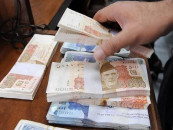Banks achieve 86% growth in profits
Boost total earnings to record high of Rs572b amid higher interest rate season

Pakistan’s banks listed on the stock market have reported an outstanding growth of 86% in their net profit in the year ended December 2023, boosting total earnings to a record high of Rs572 billion amid a higher interest rate season in the country.
The banks have managed to achieve a record high profit despite economic slowdown and underperforming industrial activities in the country.
In a brief commentary, Topline Securities’ research analyst Sunny Kumar said, “This profit was primarily driven by a significant jump in net interest income (NII) amid high interest rates and balance sheet growth.”
In US dollar terms, listed banks’ profit was up 36% to $2 billion in 2023 compared to 2022.
In a recent report, Arif Habib Limited’s economist Sana Tawfik said that almost all the listed banks have recorded their historic high profits during the calendar year 2023.
“In calendar year 2023, the banking sector in the listed space witnessed significant profits (i.e., 86% year-on-year) driven mainly by policy rate hikes of 600 basis points coupled with volumetric growth in deposits (over 24% in 2023 compared to 2022),” she said.
The net profits were also “supported by 21% lower provisioning (bad loans or non-performing loans) and 16% higher non-interest income during the year.”
However, with rates likely to have peaked, she foresees the onset of a monetary easing cycle in the ongoing first half of 2024, leading to a decline in rates, down from the current record high of 22%.
Read: Bank financing hits record high
Despite the projected decline in sector net interest margins in the latter part of the ongoing calendar year 2024 due to a likely reversal in monetary policy stance (interest rate cut), AHL’s optimism regarding the overall profitability outlook remains unwavering.
“We find several mitigating factors supporting this positive sentiment, including the lagged re-pricing of assets versus funding cost, potential expansion of the balance sheet, sustained support from non-interest income, reduced inflationary pressure mitigating operating expenses, and the opportunity to realise capital gains on the fixed PIB (Pakistan Investment Bonds) portfolio. We expect the sector’s near-term earnings to maintain strength, with full-year CY24 earnings growth estimated at 12%.”
However, it is important to note potential challenges such as the implementation of IFRS-9 and the possibility of Non-Performing Loan (NPLs/bad loans) accretion exceeding projections, which could dampen the overall financial performance of the sector, she said.
Last week, Moody’s Investors Service upgraded Pakistan’s banking sector outlook to stable (Caa3) from negative, believing the financial institutions’ solid profitability and stable funding and liquidity provide an adequate buffer to withstand the country’s macroeconomic challenges and political turmoil.
It, however, raised a serious concern on banks lending depositor money mostly to the government under the provided high-interest rate and high inflation scenario, leaving a little chunk of the funding for the private sector, which remains the engine of economic growth in the country.
“High-interest rates and inflation will continue to curb private-sector spending and investment. Furthermore, banks are financing the sovereign’s wide fiscal deficits, leaving little space to lend to the real economy.”
Pakistani banks remain highly exposed to the government via large holdings of government securities that amount to around half of total banking assets, which links their credit strength to that of the sovereign.
Government securities account for 51% of Pakistani banks’ total assets and around nine times their equity.
Deepening financial inclusion and remittances from non-resident Pakistanis are broadening domestic deposit inflows. Banks are mainly deposit-funded, with customer deposits accounting for 58% of total assets as of September 2023, and have very low reliance on more volatile market funding (5.6% of tangible assets as of December 2022) given limited access to international debt markets.
AHL expert Tawfik further said that in 2023 the banking sector demonstrated an outstanding performance, achieving remarkable milestones that surpassed previous records. One of the key highlights was the substantial increase in dividends, which surged by an impressive 84% compared to the previous year.
Resultantly, this exceptional price performance led to the banking sector outpacing the Pakistan Stock Exchange (KSE100 index), with a whopping 85% return compared to the index’s 55% during 2023.
Customer deposits at banks grew 21% in the past one year to Rs27.54 trillion in January 2024 compared to Rs22.75 trillion in the same month of last year.
Bank deposits grew for two major reasons – conversion of workers’ remittances into Pakistani rupees and soaring government debt taken from local banks. Both transactions are shown in deposits. The local relatives of overseas Pakistanis who send funds back home deposit them in banks.
The government borrowed from banks for deficit financing, but the money continued to remain parked in banks, which inflated the deposit size.
Published in The Express Tribune, March 13th, 2024.
Like Business on Facebook, follow @TribuneBiz on Twitter to stay informed and join in the conversation.


















COMMENTS
Comments are moderated and generally will be posted if they are on-topic and not abusive.
For more information, please see our Comments FAQ